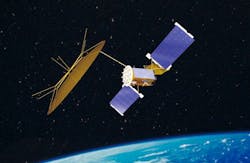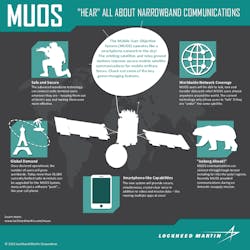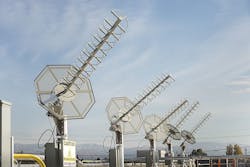Tactical satellite enables joint communications, data sharing in Pacific theater
By Argie Sarantinos-Perrin, U.S. Army Program Executive Office - Command, Control and Communications Tactical (PEO C3T)
FORT SHAFTER, Hawaii, 23 Feb. 2016. Army and Navy personnel jointly demonstrated -- on 18 Feb. 2016 at Fort Shafter, Hawaii -- how an integrated suite of network technology can effectively provide communications throughout the Pacific theater. Soldiers in five geographically disperse locations -- on land and at sea -- were able to talk, text, share data, and track the ship's progress using the Army's manpack radios and friendly-force tracker Joint Battle Command-Platform (JBC-P) with the Navy's Mobile User Objective System (MUOS) satellite communications (SatCom) waveform.
"As the Army focuses more on the Pacific theater, it is critical for soldiers in that region to be able to communicate back to land when they are traveling thousands of miles at sea," explains Col. James P. Ross, the Army's project manager for Tactical Radios. "The Manpack Radio and MUOS waveform, along with JBC-P, enable Soldiers to not only share en route mission command information, but to also know where friendly and enemy forces are located."
Similar to 3-G cellular service, the MUOS waveform keeps users -- on ships, in submarines, aircraft, and vehicles and while dismounted and on the move -- connected to high-quality voice and mission data. With 10 times more capacity than the Ultra High Frequency (UHF) system that it is replacing, the MUOS system provides additional bandwidth, eliminating connectivity and data sharing problems. With additional bandwidth, United States Army, Pacific Command (USARPAC) units that deploy to Southeast Asia where there is limited bandwidth can stay connected and exchange voice and data.
"MUOS fills an urgent need for additional tactical satellite within the Pacific," says Lt. Col. Joseph Pishock, 25th Infantry Division (ID) G6 (communications officer). "There currently are not enough channels to support units deployed into the Asia-Pacific Theater reliably. With MUOS, we can conduct simple chats, send small images and even use it with other systems to transmit position location information."
The exercise included an LSV-2 equipped with a manpack radio and a vehicle on the move antenna integrated into its communications system that travelled between two islands -- Oahu and Hawaii. The vessel was transporting military equipment and supplies for the 25th ID with soldiers from the 8th Theater Sustainment Command (TSC) onboard communicating with soldiers at two locations in Oahu and Hawaii. Each location was equipped with a manpack radio using the MUOS waveform, which enabled soldiers at all five locations to communicate with each other through JBC-P's easy-to-use interface. In addition to communicating continuously via voice and data from the LSV back to land, commanders tracked the ship's location.
As the Army's main fighting force in the Pacific region, the 25th ID frequently deploys small units to allied countries throughout the Pacific Rim to conduct joint exercises and humanitarian assistance. Reaching allied countries such as Malaysia or Australia can take eight to ten days from Pearl Harbor, Hawaii, and with major weather events, particularly the rainy season, often resulting in hours or days without communications.
"The ability to project and sustain forces from over the shore is an essential capability in the Pacific Command area of operations and a critical component of a multi-dimensional logistics network," says Maj. Edward F. Dorman, III, commander, 8th Theater Sustainment Brigade. "Enhancing the communications capability will improve how we conduct inter-island surface deployment support, add flexibility to cargo transportation options for the joint force and rapidly respond to crisis throughout the region, including humanitarian assistance situations."
Both the 8th TSC and 25th ID, subordinate commands of USARPAC, use Single Channel Ground and Airborne Radio System (SINCGARS) radios for internal communications, but the 25th ID ground unit commanders have difficulties communicating and receiving current status updates or coordinating link up operations with Soldiers on the LSVs who are transporting their equipment.
"Ship to shore communications from Army watercraft to supported units has been a challenge historically," Pishock says. "The limited systems on the LSVs do not permit ground-based forces to connect reliably from over the horizon."
The exercise highlighted how the Manpack Radio and MUOS waveform can provide effective voice and data to soldiers throughout the Pacific Theater even when they are beyond line-of- sight (BLOS). One of the key features of the two-channel manpack radio is its ability to run different waveforms, including the BLOS MUOS waveform on one channel and the Soldier Radio Waveform or SINCGARS waveform on the other channel, allowing units that are BLOS to connect seamlessly, increasing the effectiveness of the overall system.
The holistic MUOS system, managed by the Navy's Communications Satellite Program Office, includes satellites, ground stations, radios, waveforms, and network management software, all working in lockstep to provide multiple paths for information to take, something critical in keeping troops connected regardless of the extreme environment or vast distances. It also is comprised of four geostationary satellites that each cover half of the planet, with overlap to provide redundancy, and ground stations around the world. A fifth and final satellite will be launched in May as a backup in case one of the other satellites goes down.
Simply put, a message travels from the manpack radio to a satellite, satellite to ground station, ground station back up to satellite and satellite back down to the receiving manpack radio. Messages are delivered quickly -- in less than a second and a half -- even after travelling more than 100,000 miles.
The graphics and data are displayed on JBC-P, which leverages the Blue Force Tracking II satellite for situational awareness and friendly force tracking so commanders on land are able to follow the ship's progress. JBC-P is compatible with the Army's smartphone-like Nett Warrior end-user device, which integrates with tactical radio networks and provides situational awareness by displaying units, obstacles, graphics and mission essential information. The Nett Warrior attaches to the manpack radio.
"MUOS-enabled radios have a lot of potential to improve mission command over our network for all of our forces throughout the Pacific by providing access to tactical satellite resources, strategic world-wide networks and blue force tracking," says Lt. Col. Dustin Bishop, 8th TSC G6 (communications officer). "Furthermore, it will enhance connectivity from Southeast Asia to Hawaii, enabling chat, file transfers and DSN phone calls. We would even be able to provide a radio to expeditionary elements who could use it on the ground as mission dictates."
Lockheed Martin is currently under contract to deliver five MUOS satellites and the associated ground system to the U.S. Navy.
Lockheed Martin Space Systems, Sunnyvale, Calif., is the MUOS prime contractor and system integrator. The Navy's Program Executive Office for Space Systems, Chantilly, Va., and its Communications Satellite Program Office, San Diego, Calif., are responsible for the MUOS program.
The U.S. Army's Program Executive Office for Command, Control, and Communications Tactical (PEO C3T) acquires and fields the weapons systems that connect Soldiers to the Commander, Joint Services, Combat Power and Support. PEO C3T integrates the Army by providing Command and Control tactical radios, satellite communications, networks, battlefield power and integration, and battle command applications for its mission areas. In addition, it provides maneuver, fire support, air defense, intelligence and combat service support.
You might also like:
Subscribe today to receive all the latest aerospace technology and engineering news, delivered directly to your e-mail inbox twice a week (Tuesdays and Thursdays). Sign upfor your free subscription to the Intelligent Inbox e-newsletter at http://www.intelligent-aerospace.com/subscribe.html.
Connect with Intelligent Aerospace on social media: Twitter (@IntelligentAero), LinkedIn,Google+, and Instagram.
Intelligent Aerospace
Global Aerospace Technology NetworkIntelligent Aerospace, the global aerospace technology network, reports on the latest tools, technologies, and trends of vital importance to aerospace professionals involved in air traffic control, airport operations, satellites and space, and commercial and military avionics on fixed-wing, rotor-wing, and unmanned aircraft throughout the world.





